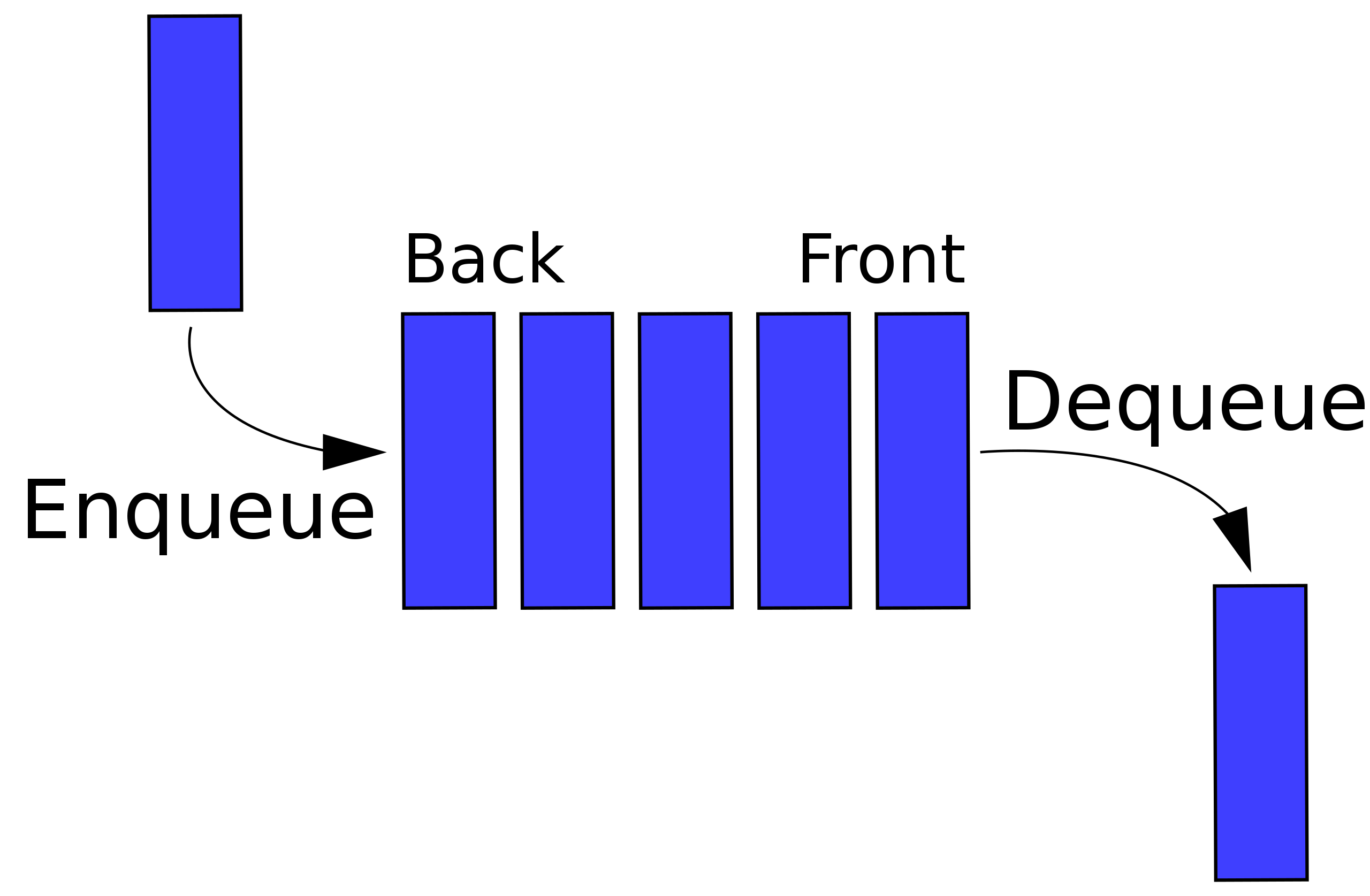Queue
Queue is a first-in-first-out (FIFO) ordered list: the datum comes in first comes out first, and the datum comes in last comes out last.
When new data come in they are added to the rear. The data come out at front. This means when front cursor moves only when data come out, and rear cursor moves only when data come in.
Code implementation
As an ordered list, a queue can be implemented using either an array or a linked list. Here we will use array.
Implementing using unidirectional array
Besides the array, a queue should also have a max size, a rear cursor and a front cursor.
public class ArrayQueue<T>
{
int front = -1;
int rear = -1;
int maxSize;
Object[] queue;
}Here we use front exclusively and rear inclusively, where front points to one element before the head and rear points to just the element at the tail.
They both start from -1. We do not use 0 as the start as that means there is already an element in the queue.
Add a constructor to specify maxSize and to initialise queue:
public ArrayQueue(int maxSize)
{
this.maxSize = maxSize;
this.queue = new Object[maxSize];
}Now we are going to enqueue and dequeue data.
As aforementioned, the rear cursor should move when new data enqueue.
We should also check if the queue is full already.
public boolean enqueue(T elem)
{
if (this.isFull()) return false;
this.rear++;
this.queue[rear] = elem;
return true;
}Where the auxiliary method isFull is defined as
public boolean isFull()
{
return this.rear == this.maxSize - 1;
}And now dequeue data. As aforementioned, the front cursor should move when dequeuing.
We should make sure the queue is not empty, otherwise an exception should be thrown.
After popping out the element, restore its position to a default value (can be defined in a constructor).
@SuppressWarnings("unchecked")
public T dequeue()
{
String err = "Cannot dequeue an empty queue";
if (this.isEmpty()) throw new RuntimeException(err);
// front always point to the element *before* head
// so front++ points to the dequeuing elem.
this.front++;
// the type cast throws compiler warning.
// disabled with annotation.
T res = (T)this.queue[front];
// restoring this elem to $defaultVal.
this.queue[front] = defaultVal;
return res;
}Where the auxiliary method isEmpty is defined as
public boolean isEmpty()
{
return this.rear == this.front;
}Till now we have finished most features of a queue, where you can enqueue and dequeue data, while checking if the queue is full or empty.
Let's add some more features:
Check size:
public int size()
{
return this.rear - this.front;
}Peek the most front element:
@SuppressWarnings("unchecked")
public T peek()
{
String err = "Cannot dequeue an empty queue";
if (this.isEmpty()) throw new RuntimeException(err);
return (T)this.queue[front + 1]; // suppressed warning
}toString() override:
public String toString()
{
return toString(" , ");
}
public String toString(String sep)
{
String[] body = new String[this.maxSize];
for (int i = 0 ; i < maxSize ; i++)
{
Object o = this.queue[i];
body[i] = (o == null ? "" : o.toString());
}
return format("[%s]" , join(sep , body));
}Flaw
You may have spotted that cells are no longer reused after its element been popped out. This could be a great memory waste.
To optimise memory use, we can use the idea of circular array.
Optimising with circular array
Circular array in short: connecting head and tail of an array. So when a cursor exceeds array length, it should be restored to 0.
We are not going to apply that to front or rear, or it could be tough to calculate queue size. Instead, these two cursors can go on infinitely; if we'd like to look at what's their index, we could use their modulo with queue size.
Suppose we have a circular array of length 4. If a cursor is on 5, then it is on position 1 as 5 % 4 = 1; if it is on 7, then it is on position 3; a diagram could be helpful for understanding.
We can write a method to calculate this index:
private static int index(int cursor , int length)
{
return cursor % length;
}With help of index positions, we can rewrite enqueue and dequeue as to avoid index of bound error:
public boolean enqueue(T elem)
{
if (this.isFull()) return false;
this.rear++;
this.queue[index(rear , maxSize)] = elem;
return true;
}@SuppressWarnings("unchecked")
public T dequeue()
{
String err = "Cannot dequeue an empty queue";
if (this.isEmpty()) throw new RuntimeException(err);
// front always point to the element *before* head
// so front++ points to the dequeuing elem.
this.front++;
int frontIndex = index(front , maxSize);
// the type cast throws compiler warning.
// disabled with annotation.
T res = (T)this.queue[frontIndex];
// restoring this elem to $defaultVal.
this.queue[frontIndex] = defaultVal;
return res;
}We also need to rewrite isFull. This time we simply check if number of elements equals max capacity:
public boolean isFull()
{
return (rear - front == maxSize);
}isEmpty works fine and do not need a change.
Also modify method peek in case of array index out of bound:
@SuppressWarnings("unchecked")
public T peek()
{
String err = "Cannot dequeue an empty queue";
if (this.isEmpty()) throw new RuntimeException(err);
int frontIndex = index(front , maxSize);
if (frontIndex + 1 == maxSize) return (T)this.queue[0];
return (T)this.queue[frontIndex + 1];
}A circular array queue is herein implemented. To test, it is better to use jshell for real-time results.
